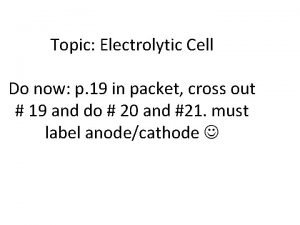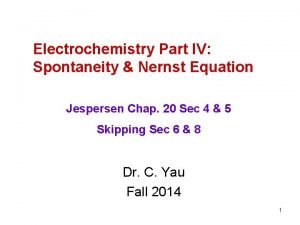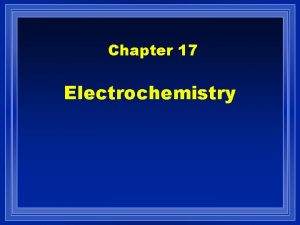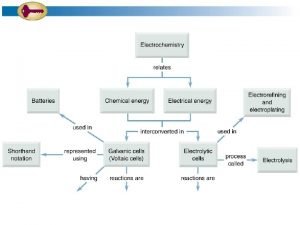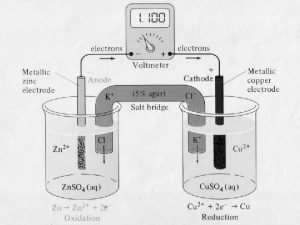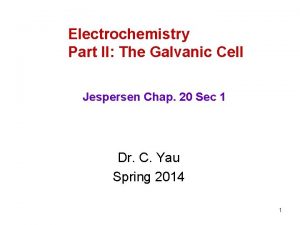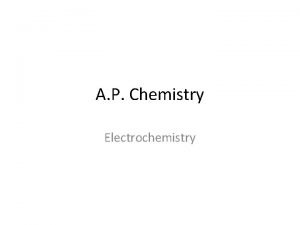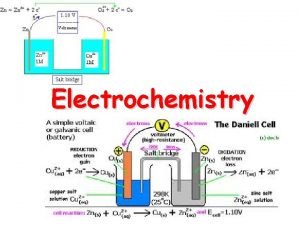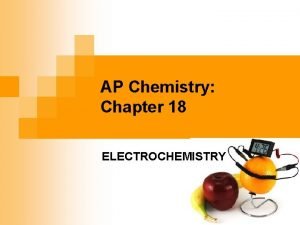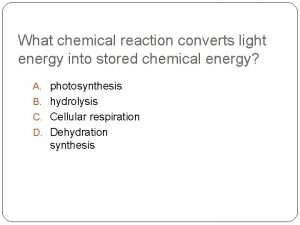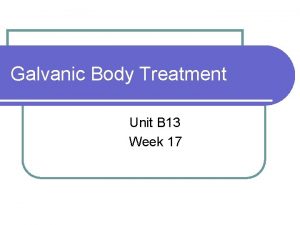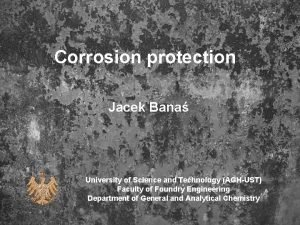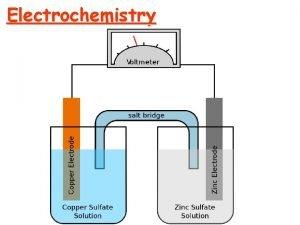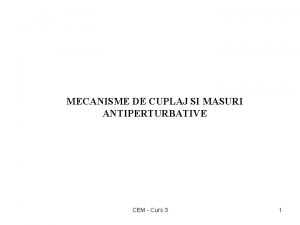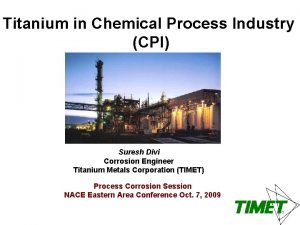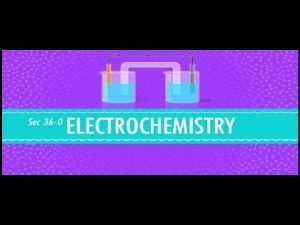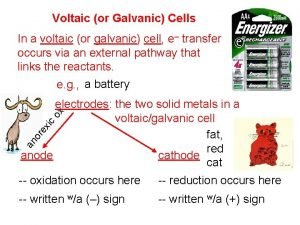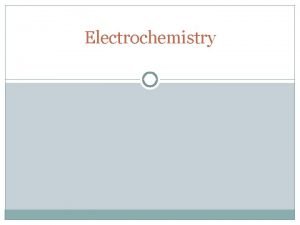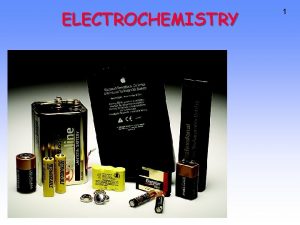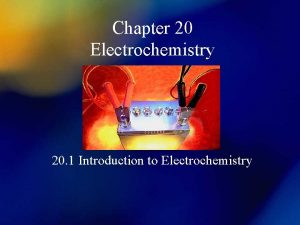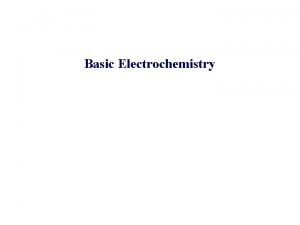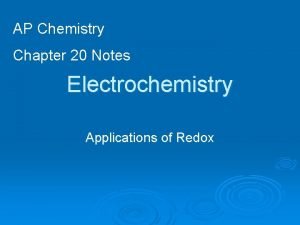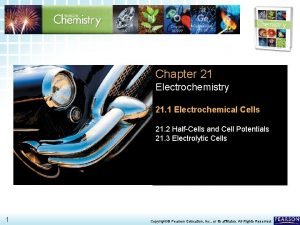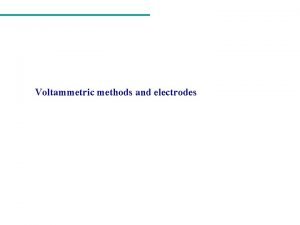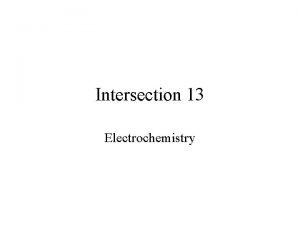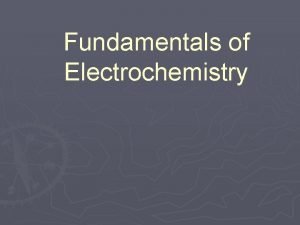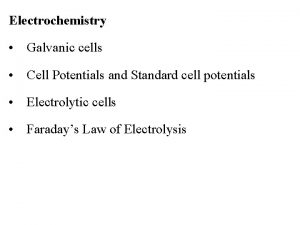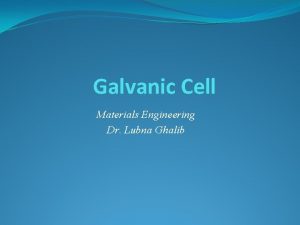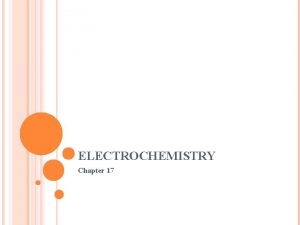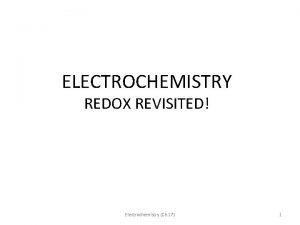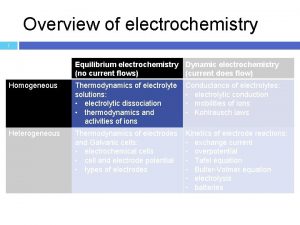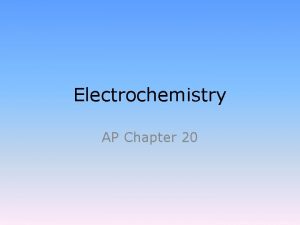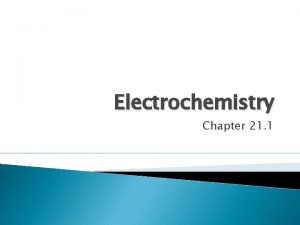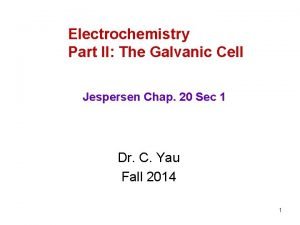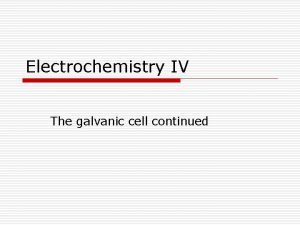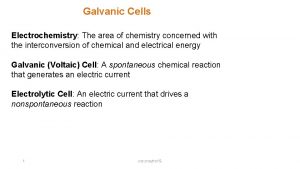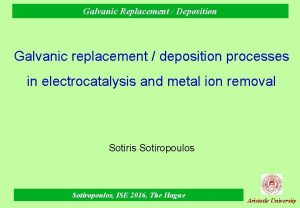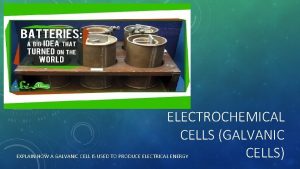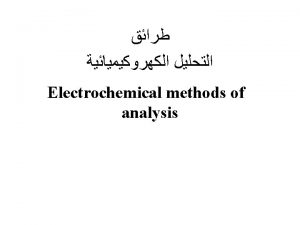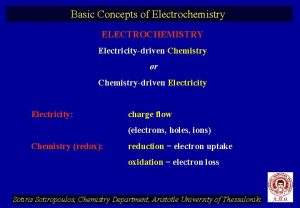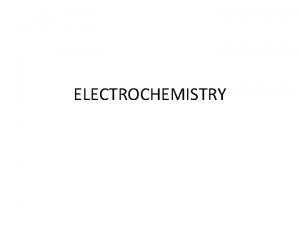ADVANCED PLACEMENT CHEMISTRY ELECTROCHEMISTRY Galvanic cell chemical energy





















































- Slides: 53

ADVANCED PLACEMENT CHEMISTRY ELECTROCHEMISTRY

Galvanic cell- chemical energy is changed into electrical energy (also called a voltaic cell) (spontaneous) Electrolytic cell- electrical energy is changed into chemical energy (nonspontaneous)

Oxidation-reduction reaction (redox)- involves the transfer of one of more electrons. Oxidation can not occur without reduction!!!

Oxidation*loss of electrons *increase in oxidation number Reduction*gain of electrons *decrease in oxidation number

OIL RIG Oxidation is loss (of e-), Reduction is gain (of e-) LEO the lion goes GER Lose electrons = oxidation, Gain electrons = reduction

Oxidizing Agent- Substance which is reduced and causes another substance to be oxidized. Reducing Agent- Substance which is oxidized and causes another substance to be reduced.

Half-reaction- Equation written to show either the loss or the gain of electrons (shows number of electrons transferred) Ex. Fe+2 Fe+3 + e− Cu+2 + 2 e− Cu

Voltaic (Galvanic) Cell The transfer of electrons can be used as an energy source if it is harnessed. One way that this may be done is by separating the two half-reactions and requiring the electron transfer to occur through a wire. The electron flow (electricity) can be used to do useful work.

The solutions must also be connected in another way or the charge will become unbalanced and the electrical flow will stop. This connection is often by a salt bridge (tube filled with conducting solution)or porous disk. Ions flow from one compartment to the other to keep the net charge zero.

Anode- The electrode at which oxidation occurs. After a period of time, the anode may appear to become smaller as it falls into solution.

Cathode- Electrode at which reduction occurs. After a period of time, it may appear larger, due to ions from solution plating out on it.

An Ox and a Red Cat Oxidation occurs at the anode, Reduction occurs at the cathode.

FAT CAT Electrons travel from anode to cathode (from reducing agent to oxidizing agent) in a galvanic cell.

Animation

Cell potential (Ecell) or electromotive force (emf): *the voltage measured across the electrodes of the half cells *the driving force of the reaction *cells with positive Ecell values are always thermodynamically favored (spontaneous) *units are volts (1 joule of work per coulomb of charge transferred) 1 V = 1 J/C

E°cell = E°ox + E°red Standard cell potential is the sum of the standard oxidation potential for the oxidation half-reaction and the standard reduction potential for the reduction half-reaction. Standard conditions are 1 atm, 25°C, and 1 M *at conditions other than standard, Ecell = Eox + Ered


Standard potentials for half-reactions: *usually written as reduction reactions (to change to oxidation, reverse reaction and change the sign of the potential) *can't be determined directly *are determined by the use of a standard hydrogen electrode (SHE) which is arbitrarily assigned a value of 0. 00 V *all other half reactions are expressed in reference to the standard hydrogen electrode

*Substances with more positive reduction potentials are more easily reduced. They act as oxidizing agents (cause another substance to be oxidized). *The more positive the reduction potential, the stronger the oxidizing agent.

*Substances with negative reduction potentials (and thus positive oxidation potentials) are more easily oxidized. They act as reducing agents (cause another substance to be reduced). *The more negative the reduction potential, the stronger the reducing agent.

http: //www. jesuitnola. org/upload/ clark/Refs/red_pot. htm

Standard hydrogen electrode(SHE)- a platinum electrode in contact with 1 M H+ and bathed by hydrogen gas at 1 atm + 2 H + 2 e H 2 o E = 0. 00 V


When combining half reactions to obtain balanced redox reactions and calculating cell potential, you do not multiply the cell potential by an integer even if you multiply the half-reaction by an integer when writing the redox reaction.

If Ecell is positive the reaction is thermodynamically favored (spontaneous). If Ecell is negative the reaction is not thermodynamical favorable (nonspontaneous). Electrons will flow in the direction that will make the Ecell positive. Voltaic experiment

Ex. What will be the spontaneous reaction between the following set of half-reactions? What is the value of E°cell? Cr 3 +(aq) + 3 e— Cr(s) E° = -0. 74 V Mn. O 2(s) + 4 H+(aq) + 2 e— Mn 2 +(aq) + 2 H 2 O(l) E° = +1. 28 V One rxn must be oxidation and the other must be reduction (we must reverse one). The sum of the two potentials must be positive. 2(Cr Cr 3+ + 3 e−) E° = +0. 74 V 3(Mn. O 2 + 4 H+ + 2 e− Mn 2+ + 2 H 2 O) E° = +1. 28 V 2 Cr + 3 Mn. O 2 + 12 H+ 2 Cr 3+ + 3 Mn 2+ + 6 H 2 O Eocell = 2. 02 V

When diagramming an electrochemical cell, the anode is traditionally drawn on the left and the cathode on the right. (Don’t count on this on a test question!)

The greater the positive potential of a cell, the greater the spontaneity of the reaction. Since G, K, and E° are all measurements of the spontaneity of a reaction, we can write equations to interrelate them.

G° = −n. FE° * G° is the standard free energy change (units are J) *n is the number of moles of electrons transferred *F is a Faraday = 96, 500 Coulombs/mol *E° is standard cell potential If E° is positive, G is negative

To find K: G° = −RT ln. K

Faraday -amount of electricity that reduces one equivalent mass of a substance at the cathode and oxidizes one equivalent mass of a substance at the anode (equivalent mass is the mass of a species that will yield or consume one mole of electron *amount of electrical charge carried by 1 mol of electrons = 96, 500 coulombs

If cell concentrations are not standard (1 M) and 25°C, the cell potential is affected. This effect can be determined by using the Nernst equation. This equation is derived from the equation used for free energy when pressures were not all 1 atm : G= G° + RT ln. Q

Nernst equation: E = E°-RT ln. Q n. F R = 8. 314 J/Kmol T = temp in Kelvin Q = ratio of concentrations or pressures of products over reactants each raised to the power of their coefficients n = number of moles of electrons transferred F = 96, 500 Coulombs/mol Another form of the Nernst equation is only valid at 25°C : E= E°−(0. 0592/n)log Q The Nernst equation is not required on the AP Chem exam. You should be able to determine whether changes in concentration increase or decrease the cell potential through the use of Le. Chatelier’s principle.

The E value calculated is the maximum potential at the very beginning of the reaction. As the reaction progresses, E decreases until it reaches zero and the battery is at equilibrium (dead).

Ex. A voltaic cell is prepared using zinc and copper strips. The zinc strips are in a 0. 40 M zinc nitrate solution and the copper strips are in a 0. 020 M copper(II) nitrate solution. At 25 C, will the cell have a voltage higher or lower than the standard cell potential? Justify your answer. Zn(s) + Cu 2+ ⇄ Zn 2+ + Cu(s) E cell = 1. 10 V Both the Zn 2+ (a product) and the Cu 2+ (reactant) concentrations are less than 1 M. However, the [Cu 2+] is significantly lower than the [Zn 2+], causing the reaction to shift toward the Cu 2+ (reactants). This makes the reaction less thermodynamically favorable and the voltage will decrease. .

Equilibrium constants can also be calculated using cell potentials. At equilibrium E = 0 and Q = K. E° = (0. 0592/n) log K

Ex. Determine whether the following reaction is spontaneous and calculate its equilibrium constant at 25°C. Sn(s) + Ni 2+ Sn 2+ + Ni(s) The half-reactions would be as follows: Sn(s) Sn+2 + 2 e− E° = 0. 14 V Ni+2 + 2 e− Ni(s) E° = − 0. 23 V E°cell = 0. 14 + (− 0. 23) = − 0. 09 nonspontaneous E° = (0. 0592/n) log K − 0. 09= (0. 0592/2) log K K = 9 × 10− 4

Electrolytic cells. When the desired chemical reaction is nonspontaneous (E°cell is negative) the reaction can proceed by the addition of electrons from an outside source. This results in the conversion of electrical energy into chemical energy. Examples are electrolysis of water, Na. Cl solution, silver plating



Faraday's Law- The amount of substance being oxidized or reduced at each electrode during electrolysis is directly proportional to the amount of electricity that passes through the cell.

Coulomb = amp × s : amount of charge that passes a given point when 1 amp of electrical current flows for 1 second. Ampere (amp) : flow rate of 1 coulomb/s (i is used as symbol for current) Joule (J): amount of energy absorbed or evolved when 1 coulomb of electrical charge moves through a potential difference of 1 V (1 J = 1 volt-coul and 1 F = 1 J/V mol)

Conversion Factors Amps ×time(s) = Coulombs 96, 500 Coulombs = 1 F = 1 mole of electrons I = q/t I = current in amps q = charge in Coulombs t= time in seconds

Dimensional Analysis is very helpful for solving electrolysis problems. current(amps) × time coulombs Faradays mol reactant g reactant or g reactant mol reactant Faradays coulombs current(amps) × time

Ex. How many grams of Cr can be plated out by passing 2. 05 amps through acidic Cr. O 3 for 1. 0 × 104 s? Cr must go from an ox # of +6 to zero, therefore 6 electrons must be gained. Cr+6 + 6 e− Cr 10000 s 2. 05 C 1 mol e− 1 mol Cr 52. 0 g Cr = 1. 84 g Cr 1 s 96, 500 C 6 mol e− 1 mol Cr Chrome plating

Ex. How many hours would it take to produce 25. 0 g of Cr from a solution of Cr. Cl 3 by a current of 2. 75 A? Cr+3 + 3 e− Cr 25. 0 g Cr 1 mol Cr 3 mol e− 96500 C 1 s 1 hr =14. 0 hr 52. 0 g Cr 1 mol e− 2. 75 C 3600 s

When a molten salt is electrolyzed, the cation is always reduced (and formed at the cathode) while the anion is oxidized (and formed at the anode). The electrolysis of molten Na. Cl: Na. Cl(l) Na(l) + ½ Cl 2(g) anode: Cl- ½ Cl 2 + e− cathode: Na+ + e− Na

When electrolysis is carried out in aqueous solutions, there is always the possibility that water will be oxidized and/or reduced instead of the solute. In order to predict the products produced when aqueous solutions are electrolyzed, you must determine the potentials of each possibility.

Ex. The electrolysis of aqueous Na. Br Possible anode reactions (oxidation): 2 Br−(aq) Br 2(g) + 2 e− E° = − 1. 09 V 2 H 2 O(l) O 2(g) + 4 H+(aq) + 4 e− E° = − 1. 23 V The first reaction occurs because it is less negative (more spontaneous)

Possible cathode reactions (reduction): Na+(aq) + e− Na(s) 2 H 2 O(l) + 2 e− H 2(g) + 2 OH−(aq) E° = − 2. 71 V E° = − 0. 83 V The second reaction occurs because it is less negative (more spontaneous). The overall reaction is: 2 H 2 O + 2 Br− H 2 + 2 OH− + Br 2 Electrolysis of KI

This method of determining whether water is oxidized or reduced does not always work. In the electrolysis of salt water (brine), we would predict that water would be both oxidized and reduced. In fact, the chloride ions are oxidized instead of the water. This is due to some fairly complex factors. This phenomenon is called overpotential or overvoltage.

The electrolysis of aqueous Cu. SO 4 : Anode: H 2 O ½ O 2 + 2 H+ + 2 e− Cathode: Cu+2 + 2 e− Cu

The electrolysis of water: Anode: 2 H 2 O(l) O 2(g) + 4 H+(aq) + 4 e− E° = − 1. 23 V Cathode: 2 H 2 O(l) + 2 e− H 2(g)+ 2 OH−(aq) E ° = − 0. 83 V E ° cell = − 2. 06 V Overall: 6 H 2 O 2 H 2 + O 2 + 4 H++ 4 OH− 2 H 2 O 2 H 2 + O 2
 Spontaneity of redox reaction
Spontaneity of redox reaction Galvanic cell and electrolytic cell
Galvanic cell and electrolytic cell Is the anode or cathode positive
Is the anode or cathode positive Nernst equation simplified
Nernst equation simplified What happens at the cathode in a galvanic cell
What happens at the cathode in a galvanic cell Galvanic cell picture
Galvanic cell picture Cathode oxidation or reduction
Cathode oxidation or reduction Oxidation numbers khan academy
Oxidation numbers khan academy History of galvanic cell
History of galvanic cell Line notation galvanic cell
Line notation galvanic cell Ap chemistry chapter 18 electrochemistry test
Ap chemistry chapter 18 electrochemistry test Danielle cell
Danielle cell What is electrochemistry in chemistry
What is electrochemistry in chemistry What is electrochemistry
What is electrochemistry Oxidation reduction memory tricks
Oxidation reduction memory tricks What are redox reactions
What are redox reactions Advanced placement incentive program
Advanced placement incentive program Advanced placement courses
Advanced placement courses As a roller coaster goes downhill
As a roller coaster goes downhill ________ converts light energy into chemical energy. *
________ converts light energy into chemical energy. * Elastic potential energy examples
Elastic potential energy examples Photosynthesis transforms light energy into chemical energy
Photosynthesis transforms light energy into chemical energy Galvanic facial aftercare advice
Galvanic facial aftercare advice Aluminium designation
Aluminium designation Oxidation and reduction in galvanic cells
Oxidation and reduction in galvanic cells Ageloc galvanic body trio
Ageloc galvanic body trio Cuplaj galvanic
Cuplaj galvanic Electrochemical theory of corrosion
Electrochemical theory of corrosion Galvanic body spa benefits
Galvanic body spa benefits Galvanic corrosion table
Galvanic corrosion table Why are galvanic cells spontaneous
Why are galvanic cells spontaneous Voltaic and galvanic cells
Voltaic and galvanic cells Ageloc galvanic body trio
Ageloc galvanic body trio Advanced inorganic chemistry lecture notes
Advanced inorganic chemistry lecture notes Ocr chemistry b
Ocr chemistry b Advanced medicinal chemistry
Advanced medicinal chemistry Energy energy transfer and general energy analysis
Energy energy transfer and general energy analysis Energy energy transfer and general energy analysis
Energy energy transfer and general energy analysis Ib chemistry functional groups
Ib chemistry functional groups Inorganic chemistry vs organic chemistry
Inorganic chemistry vs organic chemistry Faradays constant
Faradays constant What is hittorf method
What is hittorf method Electrochemistry tutorial
Electrochemistry tutorial Electrochemistry balancing equations
Electrochemistry balancing equations Electrochemistry stoichiometry
Electrochemistry stoichiometry Intro to electrochemistry
Intro to electrochemistry Basic electrochemistry
Basic electrochemistry Balance redox reactions
Balance redox reactions Ap chem electrochemistry review
Ap chem electrochemistry review Chapter 21 electrochemistry
Chapter 21 electrochemistry Equilibrium constant formula electrochemistry
Equilibrium constant formula electrochemistry Electroanalytical
Electroanalytical Electrolysis table
Electrolysis table Fundamentals of electrochemistry
Fundamentals of electrochemistry


